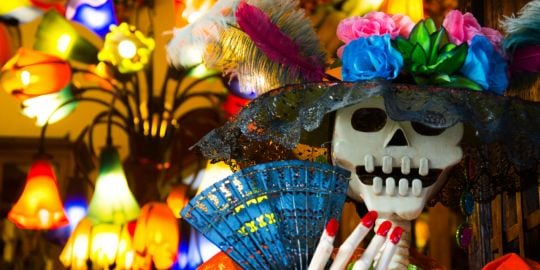I still remember picking up the earpiece and hearing a succession of quiet clicks as others on the same line would pickup and listen in on calls. https://www.flickr.com/photos/qousqous/57607074
Hobson's Choice
To avoid the click one had to lift the hand piece very very slowly. 
You must have been a sneaky young bugger, Stumpy! I would never have dared listen in without announcing my presence!
Nice photo, Dave. That black thing on the right - is that the ringer? I guess it must be, but ours was bigger and more obvious than that. Oddly, none of the houses on our exchange had an extension phone. I wonder why that was. It shouldn't have been too much of a project to have an extension out in the yard, or down at the shed half a mile away!
My mother worked in the exchange Gordon!!
Crank AKA ringer on the right, earpiece on the left and the mike on the front. The ringer would signal the operators in the telephone exchange that someone was ringing up and then the operator would plug the callers line into the desired recipients corresponding jack completing the circuit. After the call it was considered good practice to ring off allowing the operator to disconnect and free up the lins for others to use.
https://www.youtube.com/watch?v=RT4__Nz5HWY
davewatkins wrote:Crank AKA ringer on the right, earpiece on the left and the mike on the front. The ringer would signal the operators in the telephone exchange that someone was ringing up and then the operator would plug the callers line into the desired recipients corresponding jack completing the circuit. After the call it was considered good practice to ring off allowing the operator to disconnect and free up the line for others to use.
https://www.youtube.com/watch?v=RT4__Nz5HWY
Yes, I remember the "ringing off" protocol, now. I didn't know how the exchange was involved, before.
Thanks for the explanations - and thanks for the laughs from the link!
Another thing I remember from my early days (on the farm) is drinking milk straight from the cow. Well, more or less: I mean I don't think Mum or Dad ever pasteurised the stuff. The only processing I recall is separating the cream from the milk, by hand with something called... wait for it... a "separator". What do you reckon, Stumpy?
My maternal grand parents had a house cow. Milked by hand in the paddock. Nan took a small 3 legged stool out into the paddock, called the cow and then milked it. The milk was left in the bucket and the cream was skimmed off the top. Cream into the small hand churn to make butter. The rest of the milk was for consumption on porrdge, in tea, or for cooking.
As a kid I have seen and used small hand cranked milk separators on friends small landholdings. The skim milk left being fed to the pigs. Cream in a can to the factory.
Many years later these separators were desirable to make large spit roasters as the gearing was ideal to slowly turn the spit.
Thanks, Stumpy. I was wondering how come there is such a fuss these days about drinking "raw milk" (unpasteurised). You and I both survived it, with only minimal brain damage, apparently...
Gordon Barlow wrote:I was wondering how come there is such a fuss these days about drinking "raw milk" (unpasteurised).
Especially cheese from raw milk tastes far better than any other.
Here in the EU, they are widely available, but many other countries forbid them (e.g. USA) or don't have them for other reasons (e.g. all tropical countries - they do spoil faster and then could cause diseases).
A farmer near my place, who sells fresh untreated milk directly to consumers (bring your own empty bottle!) has a sign in his premises: "Due to hygiene regulations, we must inform you that our milk is not fit for human consumption without prior heat treatment!" We blissfully ignore that (as does he, himself).
We unfortunately live in an age where more and more of our actions (and the rules governing them) are dictated by fear. And the longer you think about any residual risk, the bigger they become (and the more new ones you imagine)!
beppi wrote:We unfortunately live in an age where more and more of our actions (and the rules governing them) are dictated by fear. And the longer you think about any residual risk, the bigger they become (and the more new ones you imagine)!
I agree with you on one side. On the one hand there are some paranoid behaviours regarding hygiene (food hygiene, 99% germicidal detergents, etc.) and on the other hand the same people consume or use food and care products with some questionable ingredients.
Before I came here I have always taken care to use only products with a few and not too harmful ingredients.
But here in Vietnam it is almost impossible to find such products.
Especially in the case of skin care products, it is sometimes questionable what is added to the products (that are praised as natural or organic) for questionable ingredients.
I think our body can handle natural viruses and bacteria better than with some toxic and carcinogenic ingredients.
Because while raw milk is good for small farms and families, it is dangerous when scaled up to the point needed to feed a city or civilization like the one we live in. When you look at a small sample size of 4-8, ie your family, it's not surprising none of you got sick from raw milk. When you look at a sample size of 100,000, or a few million, you will see hundreds of people getting sick from it.
Dylanc78 wrote:Because while raw milk is good for small farms and families, it is dangerous when scaled up to the point needed to feed a city or civilization like the one we live in. When you look at a small sample size of 4-8, ie your family, it's not surprising none of you got sick from raw milk. When you look at a sample size of 100,000, or a few million, you will see hundreds of people getting sick from it.
Fair point, Dylan.
https://en.wikipedia.org/wiki/Raw_milk# … zed_debate
Well, Xmas is over and all the presents have been unwrapped. So how many of you (when you were young) had mothers who insisted that all the wrapping paper be carefully taken off without tearing and stored in a drawer until next Xmas? Which drawer? Well, the one where the varying lengths of string, and pins, and scraps of paper were kept. Ours didn't have a special name, that I can recall.
Haha. I used to be like that. Now I don't care anymore. But it does save money, so just bear with her.
Yes Gordon. We had to open our presents carefully, fold the wrapping paper for reuse. This went into a box which was kept in parent's wardrobe.
The catch cry being "waste not want not" This applied to all things in my younger days.
Clothes, shoes etc handed down. Recycling before it became fashionable. 
stumpy wrote:Yes Gordon. We had to open our presents carefully, fold the wrapping paper for reuse. This went into a box which was kept in parent's wardrobe.
The catch cry being "waste not want not"; This applied to all things in my younger days.
Clothes, shoes etc handed down. Recycling before it became fashionable.
Yes, I hadn't thought of hand-me-downs as recycling, but you're quite right.
For most of us kids, in days gone by, we had Hobson's Choice when it came to clothes. My mother made all mine until I was seven, when I got my first store-bought set of shirt and short pants. I don't know if I chose it or not, but I liked it. To my fury, though, my four-year-old brother was allowed to have a matching set - at age four, for goodness sake!
Then I went off to boarding school at age eleven, where my clothes were chosen for me, too. I guess I must have been working in the city at age 17, before I got to choose my own gear, bought out of my minuscule wage!
I've just thought of another area of life in which we had Hobson's Choice - medical attention! there was no medical insurance back in the day, so doctors and dentists had to be paid out of the family's funds, and almost always that meant home treatment. I don't recall ever being treated by a doctor until I was 22, when I got a grumbling appendix that requires removal on a day when things weren't busy at work.
Mum handled every problem and dispensed what medicine there was in the house. I remember getting a sore on the top of my foot that went septic, when I was eight or nine, and having it cured by putting my foot in damn-near-boiling water two or three times a day until the boil (or whatever it was) went away.
We probably weren't any healthier than the kids of today, but we had to be pretty sick to be excused from our chores.
Out in the bush, the nearest doctor was 30 miles away (an hour's drive, on that dirt road), and the nearest hospital was twice as distant in the other direction. The only time we visited a hospital was when the whole family piled into the car to take our baby brother there for peritonitis (diagnosed over the phone by a doctor there). We must have stayed overnight, or maybe longer; I can't recall, because this would have been 70 years ago. We tried our best to schedule our illnesses until school holidays when we visited the grandparents in "the big smoke".
Even though we lived on the edge of town we had to be dying before we went to the doctor. Boils were lanced and then a hot bread poultice slapped over it to draw the pus out. The area was also dusted with powdered sulphur.
For skin complaints we were put in a hot bath into which freshly picked tea tree leaves were added. The local Maoris used this and now tea tree oil is available over the counter.
Colds and runny noses were treated with Vicks Vaporub added to a large bowl of boiling water. We leaned over the bowl with a towel over our heads and breathed in the fumes.
I have been taken to hospital by ambulance only twice, first was due to a car accident when I was 7 and next was a burst appendix at 9 years old.
Gordon Barlow wrote:Thanks, Stumpy. I was wondering how come there is such a fuss these days about drinking "raw milk" (unpasteurised). You and I both survived it, with only minimal brain damage, apparently...
Raw milk, if handled properly is better than any pasteurized milk. The pasteurization denatures it, stripping it of some of its valuable nutrition. One way people used to preserve milk before refrigerators was to put a silver coin in the bottle. (Hard to find those today) The silver has a strong antibacterial/antifungal/antiviral effect that kept the milk pure for several days. Of course, you still have to handle it well from the cow to the bottle.
Silver purification is used in the medical and airline industry, I guess the reason it was not done en masse with milk was due to the consolidation of pasteurization practices in the dairy industry.
Thanks for the explanation, West. Before we got a fridge (a kerosene one***) we just kept the milk in as cool a place as we could find, because Dad milked the cows first thing every morning, and the milk didn't have time to go off. I'm sure every farm must have a fridge these days, but I'll bet the cows still get milked every morning!
*** We had no electricity in the house for as long as we lived there (until 1955) except for overhead lights. Dad cranked up the bank of 110-volt (?) batteries for an hour or so each night, for the lights.










